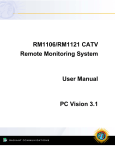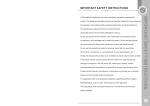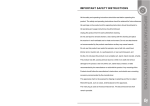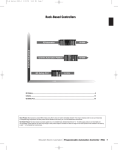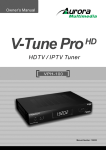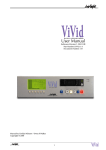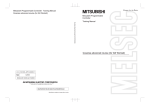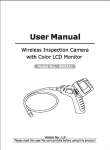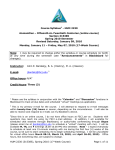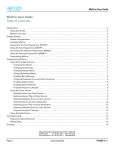Download RM1121 User Manual - RADIANT COMMUNICATIONS
Transcript
RM1121 CATV Remote Monitoring System User Manual PCVision 3.63.16 Copyright© 2015 by Radiant Communications Corporation. All rights reserved. Printed in the United States of America. Unauthorized use of this material without the expressed written consent of Radiant Communications is prohibited. No part of this manual may be used or reproduced in any form or by any means, or stored in a database or retrieval system, without the written permission of Radiant Communications Corporation. Making copies of any part of this manual for any purpose other than your own personal use is a violation of United States copyright laws. This manual is distributed as is, without warranty of any kind, either express or implied, respecting the contents of this manual, including but not limited to implied warranties for the manual's quality or performance. RM1121 User Manual Table of Contents INTRODUCTION .............................................................................................................. 1 Benefits ................................................................................................................................................. 1 Features ............................................................................................................................2 Hardware Controller .........................................................................................................2 PCVision .............................................................................................................................................. 2 GETTING STARTED ...................................................................................................... 3 Unpacking your RM1121 components ............................................................................ 3 Minimum Requirements ................................................................................................... 4 PC ................................................................................................................................ 4 Networking ................................................................................................................... 4 Important questions that need to be answered prior to installation........................ 5 SYSTEM SETUP ............................................................................................................... 6 Port Usage ....................................................................................................................... 6 Command and Control .............................................................................................. 6 Multimedia ................................................................................................................... 6 NAT and Multiple Users .............................................................................................. 6 Discovery and Setup of RM1121 ..................................................................................... 7 PCVision 3.63.16........................................................................................................ 7 Web Browser ............................................................................................................. 8 USING PCVISION .......................................................................................................... 11 Adding the RM1121 Device .......................................................................................... 12 Deleting a RM1121 Device. ................................................................................ .........12 Connecting to the Device ............................................................................................... 12 Logging In ..................................................................................................................... 13 Selecting Network Transport Protocol ........................................................................... 13 Configuration .....................................................................................................................................14 Adjusting Settings.......................................................................................................... 17 Video Settings ........................................................................................................... 17 Picture Settings ................................................................................................................. 18 Audio Settings .......................................................................................................... 19 PCVision Main Screen................................................................................................... 20 Using the Remote Control.............................................................................................. 20 Changing to Quad View.................................................................................................21 RM1121 v 3.63.16 i Table of Contents RM1121 User Manual The Main Menu..................................................................................................................22 ADDITIONAL FEATURES .............................................................................................. 23 Taking Control of the Unit ................................................................................................................23 TROUBLESHOOTING ..................................................................................................... 24 Cannot Discover RM1121 ............................................................................................... 24 No Video/Audio (After Unit is Discovered in PCVision ................................................. 24 No Audio (Video is OK) .................................................................................................................. 24 Remote Does Not Function .............................................................................................................. 25 The Screen has Color Bars ............................................................................................................... 25 APPENDIX A GLOSSARY .............................................................................................. 26 APPENDIX B SYSTEM SPECIFICATIONS .................................................................. 30 APPENDIX C KEYBOARD SHORTCUTS .................................................................... 31 INDEX ................................................................................................................................. 32 RM1121 v 3.63.16 ii RM1121 User Manual Introduction The RM1121 system is Radiant Communications' latest innovation for head-end consolidation. The system is an encoding/decoding device that provides you with the ability to remotely monitor your entire channel lineup over your existing local area network (LAN) or wide area network (WAN). The RM1121 enables transmission of high quality video signals over existing IP networks. This is an extremely flexible system with a number of features, including four selectable video inputs (each can be viewed one at a time). The encoder operates with a scalable bandwidth from 56kbs to 4Mbs in order to best manage congestion on your network. At the central location, the video can be viewed on a monitor with the use of a decoder or on a PC with just the provided software. The RM1121 is standards-based so that it will work in any IP system. It is now available with MPEG4/H.264 quality video over RTSP. The RM1121 can be used to monitor and troubleshoot the channel lineup at a hub or other remote site. The figure below displays a configuration of the basic setup. Benefits Following is a list of ways in which PCVision benefits your CATV company: • Technicians can quickly connect to unmanned hubs from anywhere. • Problems can be assessed as soon as a complaint is registered. • Multiple CATV hubs can be monitored simultaneously from one central location. • You can verify problems and reduce the number of onsite service calls. • Real-time messaging capability can be used to quickly diagnose problems. • The solution is customizable, enhancing future options for remote control of unmanned sights. • You can take a proactive approach to QoS of your CATV System. • The system uses standard network infrastructure. RM1121 v 3.63.16 1 Introduction RM1121 User Manual Features Below is a list of the RM1121 system's most useful and unique features: • Remote channel lineup monitoring 1. Remotely monitor your entire channel lineup, using your set top box via your existing LAN/WAN 2. Easily monitor multiple remote hub locations from anywhere on your network. • Scalable video channel bandwidth -This feature allows you to trade off the monitored video quality vs. the local area network bandwidth usage • Expandable System -you may easily add sites at any time • • Works on intranets and the Internet Operates on MPEG4/H.264 Hardware Controller The RMI121hardware controller consists of the following: • • • MPEG4/H.264 scalable video encoder Multi-protocol to accommodate different network environments Scalable from 1 to 4 inputs • IR port • Standard Ethernet networking port • 1RU Rack mount chassis • Analog decoder PCVision Some of the advantages of using PCVision are: • It is designed for quick learning and ease of use. • It uses a logical grouping scheme that defines locations and available CATV boxes. • It displays which user is in control and additional number of users connected to each RM1121. • The system allows for online administration and configuration of RM1121. • Individual passwords are assigned to Admin, Technician, and User groups for added security. • It has an easy-to-use remote control interface for accessing cable box controls. • A customization option is available. RM1121 v 3.63.16 2 RM1121 User Manual Getting Started Unpacking your RM1121 components Remove all materials from the packing box and confirm receipt of the following according to the specific product ordered: RM1121 • 1 CD (Manual and Installation Software) • 2 RJ45 Cables (1 straight and 1 crossover) • 1 A/C Power cord • • 4 6FT Triple RCA/RCA Cable 4 IR Blaster NOTE: In the event that anything is missing, contact Radiant Communication Corp. Technical Support at 800-969-3427 for product returns or missing parts. If it becomes necessary to return the unit, repackage all components in the original box(s). RM1121 v 3.63.16 3 Getting Started RM1121 User Manual Minimum Requirements PC • Pentium IV Class Processor or better • 128 MB RAM • 10-Base-T network card • Windows 2000/XP Professional (with network features enabled) • 30 MB hard disk space • Screen resolution of 1024 x 768 • Video/Audio Ports UDP 6970-6973 • TCP Control port 554 NOTE: The full PCVision setup will automatically install .NET and DX9software. If your workstation has had a previous version of PC Vision loaded the partial installed can be used. Networking • _TCP/IP ports are used. Important: For the RM1121, UDP ports in the 6970-6973 range must be open on network routers and firewalls for WAN and internet applications, This allows for proper data passage on the network and enables you to view video, hear audio, and pass necessary controls. If all UDP ports are closed on the firewall/router, you may be able to scan the unit and see it in the list of available units, however video and audio will not stream. Calculating total bandwidth required: • Video Bandwidth (56kbs-4Mbps) • Audio constant 128Kbps • Data packet overhead 10% All above added together will equal total bandwidth required to stream video, audio and data controls to one user. A second user will require the same bandwidth therefore doubling the total network traffic. RM1121 v 3.63.16 4 Getting Started RM1121 User Manual Important questions that need to be answered prior to installation By answering the questions below, your Radiant Communications representative can assess the overall picture of your user environment and make decisions on set up, problems that they may face, and overall system performance. Please read the questions below and be prepared to answer them in the event of a change in, or problems with, your configuration. • Hardware • What type of network switch gear will the system be running on? How many routers/gateways are between the user and the RM1121 What are the processor, memory, and video card specs on the viewing stations running PCVision? Software What operating system is the view station running? If it is a home work station, does it have a software firewall or virus protection on it? • Networking What network operating system is being used? What protocols are currently being used or blocked? What ports are being used or blocked? If the RM1121 Device is used on the public internet, it is strongly recommended that it be protected by a firewall between it and the public connection. A simple firewall is often present in Cable/DSL routers and while simple; it is usually sufficient to control access to the units. The more secure configuration filters access to the devices by the IP address of the client. In order to configure the firewall consult with the manufacturer's instructions. The port requirements are documented in this manual. Is the PCVision system on its own sub net or VPN/VLAN? Is there any network scanning for viruses that may block streaming servers? Can changes be made to the firewall rules and protocols for the functions of PCVision? Does the network use NAT to talk to the RM1121 behind a router? What are the available bandwidths at the locations where the units are deployed? RM1121 v 3.63.16 What are the bandwidths at the locations where viewing occurs? 5 RM1121 User Manual System Setup Make sure that there is enough space to pull and connect the Video/L+R Audio cables (RCA) and IR Blaster to the cable box. Connect RJ45 cables from the RM1121 Series unit to the network. Install the RM1121 Series units such that the environmental specifications are not exceeded. Installation in a well-ventilated, temperature-controlled area will minimize the possibility of component failure and increase systems reliability. ' Important: Read prior to setup. When installing the PCVision software, choose the Admin install for the initial setup. One Admin and any two combinations of Users or Techs can be logged on to the unit at the same time. Configuration of the unit can only be done by an Admin. Port Usage The PCVision application communicates with the RM1121 device using a number of TCP and UDP ports. It is important that these ports be opened and not blocked in order to connect to the device, view video and hear audio. Firewalls: It is highly recommended that the RM1121 devices do not have complete open access to the Internet! Please place the RM1121 behind a firewall and follow the port forwarding instructions below to protect the unit from unwanted users accessing and possibly damaging the unit. Command and Control TCP port 554 on the RM1121 device is used to send all command and control data to the unit. Since the connection to the device is outbound (from the PC client to the device) this is usually not a problem on the client end. If there are problems, it may need to be investigated on the device end. Multimedia Video and audio are transmitted via UDP packets from the device to the PC client. Video and audio are in the form of RTP packets carried over two separate UDP channels. UDP has better viewing characteristics over varying types of networks and these ports must be opened. Typically a firewall will block inbound UDP packets and the result is that neither video nor audio will be streamed to the client. You may be able to connect to the device and configure it, but video and audio are not present. . Video and audio are carried on ports 6970 through 6973 by default. Inbound traffic from the device to the PC, requires that UDP traffic be allowed on these ports. PCVision supports the viewing video from up to 9 RM1121 devices simultaneously. NOTE: While PCVision can display 9 videos simultaneously, audio will be played from the active video only. NAT and Multiple Users In order to support multiple users on a LAN, the ports used for video and audio may be configured for each individual PC. This allows for rules on the firewall to be created which will route the multimedia streams to the proper user. RM1121 v 3.63.16 6 System Setup RM1121 User Manual Discovery and Setup of RM1121 This section provides you with information on installing PCVision and setting up the unit, enabling you to control it from PCVision. PCVision 3.63.16 The PCVision software is required to properly run the RM1121 unit. Install PCVision from the CD provided. To install PCVISION: 1. Insert the CD and browse to the Setup icon on the CD. 2. Double-click the Setup Icon to start InstallShield Wizard (Figure 1). Figure 1: lnstallShield Wizard 3. Follow the instructions provided in the Install Shield Wizard to install PCVision. 4. Choosing the Admin option in the initial setup will install additional tools allowing administrators to make set up and configuration changes. NOTE: Choosing the User option only installs PCVision and is not recommended for initial setup. It is recommended that only one person has Admin rights. The additional work stations should be installed as Users or Techs unless other Admin stations are necessary. RM1121 v 3.63.16 7 System Setup RM1121 User Manual Web Browser To configure the RM1121 with your computer: 1. In the address bar of your web browser, type in the IP address of your device NOTE: The default IP address is 192.168.1.111 2. Once connected to the web browser page, there will be three tabs to select. The System tab (Figure 2) provides: Information about the Model, Model Number, and Version it is running The MAC Address of the device Figure 2: Web Browser – System Configuration RM1121 v 3.63.16 8 System Setup RM1121 User Manual The Network tab (Figure 3) provides: The network type (Static) IP Address of the device The Subnet Mask and Default Gateway of the network Figure 3: Web Browser – Network Configuration RM1121 v 3.63.16 9 System Setup RM1121 User Manual The Firmware tab (Figure 4) provides: The ability to update the firmware Username: admin Password: admin Figure 4: Web Browser - Firmware RM1121 v 3.63.16 1 RM1121 User Manual Using PCVision PCVision is your interface with the RM1121 system (Figure 5). To use PCVision to communicate with the RM1121: 1. Start the PCVision application by clicking Start, selecting Programs, and clicking on PCVision. OR Double Click the PCVision shortcut on your desktop Figure 5: PCVision Main Screen RM1121 v 3.63.16 11 Using PCVision RM1121 User Manual Adding the RM1121 Device 1. On the top left, click the Add Device button. The Add Device dialog box displays (Figure 6). Figure 6: Add Device 2. Enter the IP address of the unit. 3. Click OK to enter the address in the list. The dialog box will disappear. OR Click Apply to enter the IP address and leave the dialog box open for the next IP to be entered. Deleting a RM1121 Device 1. Click the Delete A Device button. 2. Select the device to be removed. 3. A dialog box will appear asking if you are sure you want to delete the device. 4. Select Yes to permanently remove the IP address from the list. Connecting to the Device To connect to the device: I . Highlight the IP address of the unit. 2. Click the Play button located at the bottom of the video window. The Login dialog box displays in the video window (Figure 7). Figure 7: Login RM1121 v 3.63.16 12 Using PCVision RM1121 User Manual Logging In There are three default passwords for login: • Admin - 1234 • User - 1111 • Tech - 1111 NOTE: You can allow users to login without entering a password by going into Change Password and entering 0000. Only four users, including one Admin can be logged in at the same time. Users with higher privileges have first priority. After login, Connected shows in the lower left hand corner. If user is not in control, the Remote will be grayed out and the bottom left will show "playing video and audio". Selecting Network Transport Protocol RTP Video/RTP Audio uses UDP protocol and supports synchronized audio/video streams. You must have appropriate network ports open in order to use this option. PCVision is configured to use RTP/RTP by default but will remember your last protocol selection upon restart. TCP Video/TCP Audio uses a dedicated TCP connection for audio and video. It does not support synchronized audio/video and limits the box to 2 connections. While this option does not require ports to be opened, it does require proper bandwidth allocation based on video and audio settings. TCP Video/RTP Audio uses a dedicated session of TCP for Video only. This is appropriate for VPN applications where the UDP QOS is low and does not run will in full UDP mode. NOTE: Login is only required the first time connecting to the unit. After the initial login, user rights will be remembered while the program is running. In addition, users will login automatically to other boxes that have the same password as a box previously logged into. To select network transport protocol: 1. On the PCVision main screen, click the Tools menu. 2. Select Options. The dialog box displays. 3. Select from the General tab the appropriate protocol set for your network configuration. RM1121 v 3.63.16 13 Using PCVision RM1121 User Manual Configuration Configuration of the unit can only be done by an Administrator. To configure a device: 1. Once connected to the selected device, select the Device option 2. Select Configure. The Configure Device dialog box displays three tabs. The General tab (Figure 8) provides: • Option to view or edit the device name • Device Type shows the number of ports within the device. • General Device information • · Setting for Maximum Bitrate value Figure 8: Configure Device - General Tab RM1121 v 3.63.16 14 Using PCVision RM1121 User Manual The Permissions tab (Figure 9) provides: • Allows set up of User, Tech, and Admin options • Sets passwords • Sets idle timeouts Figure 9: Configure Device - Permissions Tab RM1121 v 3.16 15 Using PCVision RM1121 User Manual The Inputs tab (Figure 10) provides: • The ability to change remote control options • The display shows the current IR configuration by remote control names and file number. • To change remote select the Change tab and the remote control required. • The remote code will automatically upload and the remote image on the right side of the screen will change to the newly selected file. Figure 10: Configure Device - Inputs Tab RM1121 v 3.63.16 16 Using PCVision RM1121 User Manual Adjusting Settings Video Settings To adjust the video settings: 1. On the PCVision main screen, click the Video tab at the bottom of the screen. The Video Settings display (Figure 11). Figure 11: Video Settings 2. This tab allows you to select Bitrate, Inputs, Input Filter Mode, Quality, and Frame Rate Control. NOTE: To adjust maximum bitrate, open the Device menu and select Configure... Maximum Bitrate displays on the General tab. This sets the ceiling on maximum bitrate video (see figure six page 16). 3. These options are hidden by default. Click the Advanced Controls hyperlink to expose these configuration values. The advanced settings display (Figure 12). Figure 12: Advanced Video Settings 4. To revert to the default settings, click the Reset hyperlink. RM1121 v 3.63.16 17 Using PCVision RM1121 User Manual Picture Settings You may adjust several settings that control the color and clarity of the image including bandwidth, brightness, contrast, hue, and saturation. To adjust picture settings: 1. On the PCVision main screen, click the Picture tab at the bottom of the screen. The picture settings display (Figure 13). Figure 13: Picture Settings 2. Adjust the picture quality values by dragging the slide bars for Brightness, Saturation, Contrast, and Hue. The following table describes how to change these settings. To adjust... Do this... Brightness Drag the Brightness slider on the picture tab Contrast Drag the Contrast slider on the picture tab. Hue Drag the Hue slider on the picture tab. Saturation Drag the Saturation slider on the picture tab. 3. To revert to the default settings, click the Reset hyperlink. RM1121 v 3.63.16 18 Using PCVision RM1121 User Manual Audio Settings PCVision provides you with several tools for adjusting the audio on your unit. To adjust audio settings: 1. On the PCVision main screen, click the Audio tab at the bottom of the screen. The audio settings display (Figure 14). Figure 14: Audio Settings 3. Adjust the audio settings by dragging the Volume slide bar to raise or lower the audio levels. 4. To revert to the default settings, click the Reset hyperlink. NOTE: For an explanation of Rate Control, see the definition in Appendix A Glossary. RM1121 v 3.63.16 19 Using PCVision RM1121 User Manual PCVision Main Screen Think of the PCVision main screen as your control panel. All of the functions that you need to perform are done from this screen. Figure 15 illustrates the various components of the PCVision main screen. · Figure 15: PCVision Main Screen Using the Remote Control You may use the remote control to adjust your TV settings just as you would a physical remote control. For example, you can change channels, set favorites, and change thevolume. RM1121 v 3.63.16 20 Using PCVision RM1121 User Manual Changing to Quad View You may change the screen from a single view to display 4 screens at one time, allowing you to view four units at one time. To change to quad view: 1. Click the Quad button on the toolbar. Four screens display (Figure 16). The selected unit automatically displays in the top left. 2. To select another unit, first click on the window desired to display the video, then click the unit in the list. Click the Play button. Figure 16: Quad View To may also view more than four screens at once. To change the Multi View Display: Click on Tools on the toolbar and then click on the Display tab at the top Here you will find options for Four (2x2), Six (3x2), and Nine (3x3) screens Select the option you want and click OK RM1121 v 3.63.16 21 Using PCVision RM1121 User Manual The Main Menu The Main Menu allows you to perform basic functions. The table below describes the various functions on the Main Menu. Menu Option Description File Import Configuration Displays PCVision –Import File dialog box, allowing you to import a configuration file Export Configuration Displays PCVision –Export File dialog box, allowing you to export a configuration file Exit Exits PCVision Device Configure Allows you to select and change configuration settings for the device Add Device Adds a new device which can be accessed Remove Device Removes the selected device Remote Control Keys Turns the remote control shortcut keys on and off Channel Scan Automatically changes the channel every few seconds Tools Options Allows you to change the display name, media protocols, audio/video synchronization, and starting port Full Screen Video Makes video viewing area full screen Help About RM1121 v 3.63.16 Displays PCVision version and copyright information 22 RM1121 User Manual Additional Features Taking Control of the Unit There may be times when you will want to take control of the unit so that you can perform specific functions. To take control of the unit: 1. On the PCVision main screen, select the Users tab at the bottom of the screen 2. If you are currently in control the remote will be in color and the Take Control and Request Control buttons will be grayed out. 3. If you require control, select either the Take Control options (Available only for Admin level) or Request Control. NOTE: Users must be in control of the unit in order to use the remote, adjust the picture, video, or audio settings. In addition, only an Admin in control of the device can configure the unit. Also note that permission to change these settings must be granted by an Admin. RM1121 v 3.63.16 23 RM1121 User Manual Troubleshooting Listed below are some common issues that you may encounter. Each description provides an explanation and action you may take for a solution. For additional issues and inquiries, contact the RM1121 Technical Support Group at 800-969-3427. Forgot Password In the event that the Admin password is forgotten, Radiant Communications can provide a service to recover a password. Password recovery is possible either by returning the unit to Radiant or by making the unit available on the Internet for a remote login by Radiant Communications Tech Support. Cannot Discover RM1121 Solution: Attempt to ping the unit to ensure it is responding on the network. Ensure that a proper IP address for the specific network segment the unit is on has been configured to the unit. No Video/Audio (After unit is discovered in PCVision) Reason: Ports 6970-6973 may be blocked on Network by Firewall. Solution: Check with the network administrator to confirm that ports 6970-6973 are open. If the RM1121 Device is used on the public Internet, it is strongly recommended that it be protected by a firewall between it and the public connection. A simple firewall is often present in Cable/DSL routers and while simple, it is usually sufficient to control access to the units. The more secure configuration filters access to the devices by the IP address of the client only and blocks other unwanted users from gaining access. No Audio (Video is OK) Reason: The volume on the Audio tab may be too low or the cable box audio output level may be too low. Solution: From the PCVision main screen, select the Audio tab below the main viewing screen. Use the volume slider to adjust the volume up and down. If the cable box output level is too low, try using the remote control to increase the volume. Some multi-function remote controls are set to only control the TV volume level. These remotes will also have that limitation in PCVision. RM1121 v 3.63.16 2 Troubleshooting RM1121 User Manual No Audio (Video is OK) Reason: The volume on the Audio tab may be too low or the cable box audio output level may be too low. Solution: From the PCVision main screen, select the Audio tab below the main viewing screen. Use the volume slider to adjust the volume up and down. If the cable box output level is too low, try using the remote control to increase the volume. Some multi-function remote controls are set to only control the TV volume level. These remotes will also have that limitation in PCVision. Remote Does Not Function Reason: Either the IR Code, selected under IR set-up, does not match that of the settop box interfacing with the RM1121 unit, or you do not have permissions to operate the remote (Channel changing capability) Solution: Select Configure from the Device menu. Click on the Inputs tab. Ensure that the remote control in the IR LIB box is correct. If not, select Change and choose the appropriate remote for your set-top box. If the remote is not available in the list, contact support for additional files and loading instructions. The Screen has Color Bars Reason: The unit is streaming but there is no video signal in the RM1121. Solution: Check the video source. NOTE: Color bars may be present while channels are changing on the set-top box, while the unit locks on video sync. RM1121 v 3.63.16 25 RM1121 User Manual Appendix A Glossary Term/Acronym Analog Bandwidth Binary Bit rate Brightness CATV Central Processor Unit (CPU) Contrast Digital DVD Ethernet Hue Input format Input filter mode RM1121 v 3.63.16 Definition Technology in which a wave is recorded or used in its original form, as opposed to digital. See Digital. A range of frequencies between two defined points expressed in cycles per second, or hertz (Hz) when defining the circuit, or kilobits per seconds or megabits per second (Mbps) for a transmission line's capacity, or the capacity of a transmission channel for carrying information. A base 2 number system used in programming computers Sets the video default streaming bit-rate when the user connects to the units and streams video. A description of how bright or dark the color appears in terms of how much light is reflected back to the eye. Adding black lowers its value, while adding white increases the value. Cable TV Components of a computer that interprets and executes instructions. The difference in brightness between different parts of an image. If there is a little difference, the image has low contrast. If there is a large difference, the image has high contrast. Technology in which an analog wave is sampled at some interval, and then turned into numbers that are stored in the digital device Digital Versatile Disc or Digital Video Disc, a type of optical disk technology, commonly used as a medium for digital representation of movies and other multimedia formats that combine sound and graphics. The most widely-installed Local Area Network (LAN) technology. Ethernet networks operate at 10Mbps running over coaxial cable or twisted pair wires (TP). A description of the absolute place of color on the spectrum according to its wavelength. In the visible spectrum from infrared to ultraviolet, orange-red has a long wavelength compared to indigo which has a shorter wavelength. See NTSC. Sets the noise filter mode. A higher filter smoothes the image (i.e., removes sharp edges and noises). This allows for greater compressions at the expense of a less sharp image. A low filter setting retains image detail and the expense of less compression. Normally the unit is set to medium. If none is selected, the codec simply passes the noise through to the image. 26 Appendix A Glossary Term/Acronym I/0 IP IR Kbps LAN MAX Quantizer MB Mbps MPEG4 Multi-protocol NAT NTSC RM1121 v 3.63.16 RM1121 User Manual Definition Input/output. Used when referring to input and output devised and systems. Internet Protocol, responsible for moving packet of data from node to node. IP forwards each packet based on a four byte destination address (the IP number) Infra-Red. Kilobytes per second, used to describe data transfer rates, 1,000 bytes per second. Local Area Network, a computer network covering a local area, like a home, office, or small group of buildings. Can be set from 1-31. The maximum setting is the highest (Coarsest) value the quantizer can have. This setting is a bar for how low image quality can go without dropping frames. Higher values enable the encoder to maintain a higher frame rate. Lower values enable the encoder to maintain a higher quality images with loss of frame rate. Typically, the range should be between 8-12. Megabytes, used to describe data storage, 1,048,576 (2 to the 20th power) bytes. Megabytes per second, used to describe data transfer rates, 1,000,000 bytes per second. An ISO/IEC standard developed by MPEG, provides the standardized technological elements enabling the integration of the production, distribution and content access paradigms of digital television, interactive graphics applications, and interactive multimedia (World Wide Web, distribution of and access to content). Label switching providing an integrated approach to traffic engineering which optimizes the routing of IP traffic, routes traffic flows across a network based on the resources the traffic flow requires and the resources available in the network. Employs "constraint-based routing," in which the path for a traffic flow is the shortest path that meets the resource requirements. The flow has bandwidth requirements, media requirements, and a priority over flows. Network Address Translation, an Internet standard that enables a LAN to use one set of IP addresses for internal traffic and a second set of addresses for external traffic. Provides a type of firewall by hiding internal IP addresses, and enables a company to use more internal IP addresses and to combine multiple ISDN connections into a single internet connection. National Television System Committee. Sets the standard for television and video display in the United States. Used as a video display option in PCVision 27 Appendix A Glossary Term/Acronym PAL PIV Protocols Qos RAM Rate Control Saturation Serial port TCP/IP USB UDP RM1121 v 3.63.16 RM1121 User Manual Definition Phase Alternating Line. Sets the standard for television and video display in Europe. Used as a video display option in PCVision. Intel Pentium IV processor The special set of rules used at end points in a telecommunication connection when they communicate. Protocols exist at several levels: hardware telephone protocols, between each of several functional layers and each corresponding layer at the other end of a communication. Both end points must recognize and observe a protocol. Quality of service, attempts to provide a more efficient flow of information over a network, by providing priority traffic flows for specific networks. Random access memory. A temporary memory that looses its contents when the computer is turned off. Determines whether the unit operates in Constant Bit-rate (CBR) mode or Variable Bit Rate (VBR). By default the unit is set to automatic. This allows the encoder to decide which mode to use. VBR is used when the quality of the video is desired to be at a constant level and you wish only to use enough bandwidth as necessary to transmit that quality. CBR is used when you wish to have the encoder vary the quality as high as possible as for the current bit-rate. The intensity, or purity, of a color. Also known as chroma level. Saturation is inversely related to the amount of its opposite's color that it contains. For example, a fully saturated red contains no green or blue. Adding equal parts of green and blue to red lowers it's saturation. One of the most basic external connections to a computer, used primarily for modems and printers, although many printers and digital devices use USB pmts in the 2000's. TCP=Transfer Control Protocol, IP=Internet Protocol, is composed of layers, responsible for verifying the correct delivery of data from client to server. TCP adds support to detect errors or lost data and to trigger retransmission until the data is correctly and completely received, see also IP. Universal Serial Bus, external connection to a computer, used primarily for digital devices. User Datagram Protocol, a connectionless protocol that runs on top of IP networks. UDP/IP offers a direct way to send and receive datagrams over an IP network, used primarily for broadcasting messages over a network. 2 Appendix A Glossary Term/Acronym VHS VLAN VOD VPN WAN RM1121 v 3.63.16 RM1121 User Manual Definition Video Home System, the recording and playing standard for video cassette recorders (VCRs). It became a standard format for consumer recording and viewing in the 1980s. Virtual Local Area Network, a logically segmented network mapped over physical hardware, often configured to reduce the size of the collision domain in a large single Ethernet segment to improve performance. Video On Demand, VOD systems allow users to select and watch video content over a network as part of an interactive television system. Virtual Private Network, a private communications network used within one or more companies or organizations, communicating over a public networking infrastructure, such as the Internet, using standard protocols. Wide Area Network, a computer network that spans a relatively large geographical area, usually consisting of two or more Local Area Networks (LANs). Computers connected to a WAN are often connected through public networks, such as a telephone system, leased lines, or satellites. The largest WAN is the Internet. 29 RM1121 User Manual Appendix B System Specifications The RM1121 system specifications are listed below. Video • One NTSC/PAL (RCA) input, composite Video, 750hm, IV Video Codec • User configurable bit rate • User configurable quality • Up to 30fps • MPEG4 Audio 1/0 • Line In/Out (RCA) • 77 dB SNR • 46 to -3dBV Input Impedance 10k Ohms Network Connections • IEEE 802.3 • Protocols: Multicast, UDP, IP TCP, DHCP • Physical connection via RJ-45 • Bandwidth - 30 Kbs to 4 Mbs Dimensions • 17.0W X 13.0 D X l.7" H Power/Environmental • Operating voltage: 90 -250VAC@10W • Operating: 32 F (0 Degrees C) to 122 F (50 Degrees C) • Storage: -4 F (20 degrees) to 158 degrees F (70 degrees C) RM1121 v 3.63.16 30 RM1121 User Manual Appendix C Keyboard Shortcuts Keyboard shortcuts for PCVision are described in the table below. This is the usual set of short cuts. There are cases for specific remote files that certain keys will not correspond with the action. Press... Fl2 To... F11 Toggles keyboard between remote control input mode and normal mode Channel Scan F9 Full Screen Video ESC Exit Full Screen Video Enter A B Select an option Select button a Select button b Select button c Move to the previous page Move to the next page Select the last option Select Favorite Select Settings Select Guide Select Info Move up a channel c Page Up Page Down L F S G I O+ (+ on the Num Pad) 0- Move down a channel (- on the Num Pad) 0-9 x RM1121 v 3.63.16 Move up one option in a menu Move down one option in a menu Move to the next menu item to the left Move to the next menu item to the right Sends the corresponding digit. Exit 31 RM1121 User Manual Index A Additional Features, 23 Admin, 13 Analog, 2, 26 Audio adjusting, 19 troubleshooting, 24, 25 B Bandwidth, 26, 30 Benefits, 1 Binary, 26 Bit rate, 26 Brightness, 18, 26 F Features, 2 File, 22 Firmware, 10 H Hardware questions to ask, 5 Hardware Controller, 2 Help, 22 About, 22 Hue, 18, 26 C CATV, 26 Central Processor Unit, 26 Configuration, 14 Connecting, 12 Contrast, 18, 26 CPU, 26 D Digital, 26 Discover troubleshooting, 24 Discovery PC Vision, 7 E Ethernet, 26 Exit, 22 Export configuration, 22 RM1121 v 3.63.16 I I/0, 27 Import configuration, 22 Input filter mode, 26 Input format, 26 IP, 27 IP Address default, 8 IR, 27 K Kbps, 27 Keyboard Shortcuts, 31 L LAN, 27 Logging In, 13 M MAX Quantizer, 27 MB, 27 Mbps, 27 Minimum Requirements, 4 Networking, 4 PC, 4 32 Index RM1121 User Manual MPEG4, 27 Multi-protocol, 27 RM1121 Device Adding to PC Vision, 12 N NAT, 27 Network Configuration settings, 7 Networking questions to ask, 5 noise filter mode, 26 NTSC, 27 P PAL, 28 Password troublshooting, 24 PC Vision, 2 adding the RM1121 Device, 12 main menu, 22 Port Usage, 6 Ports command and control, 6 multimedia, 6 NAT and multiple users, 6 Protocols, 28 S Saturation, 18, 28 Screen troubleshooting, 25 Serial port, 28 Software questions to ask, 5 System setup, 6 IR Blaster, 3, 6 Video, 6 System Specifications, 30 Audio 1/0, 30 Dimensions, 30 Network, 30 Video, 30 Video Codec, 30 T Take control, 23 TCP/IP, 4, 28 Tech, 13 Troubleshooting, 24 U UDP, 28 Unpacking, 3 USB, 28 User, 13 R RAM, 28 Rate Control, 28 Remote control troubleshooting, 25 Remote Control, 20 RM1121 v 3.63.16 VHS, 29 Video Settings, 17 Video/Audio troubleshooting, 24 VLAN, 29 VOD, 29 VPN, 29 W WAN, 29 33






































